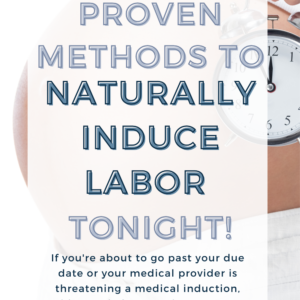Most first time moms (and even second and third) don’t know the right way for timing labor contractions. So they end up heading to the hospital or birth center too early or too late! Learn the correct way for timing labor contractions to know what stage of labor you’re in and when to get ready to meet baby.

What are Contractions?
[convertkit form=1775034]
What do contractions do?
Before you know what a contraction is, you need to know what it does. The cervix is the opening that connects the uterus to the birth canal. Think of it looking like a turtleneck sweater. The cervix remains closed and thick during most of pregnancy. Contractions do the real work during labor, creating the opening of the cervix wide enough and thin enough for baby to come through.
So many people don’t understand how a baby’s head can fit through the vagina. The vagina seems so small in comparison. Normally it is. Labor contractions are what makes the opening and vagina big enough for baby to pass through. The long work of labor is just for contractions to pull back and open the cervix.
In the uterus, baby’s head rests down on top of the cervix. Contractions pull the cervix open and back over baby’s head. It’s just like pulling a turtleneck sweater down over your own head.
What are contractions?
You may have heard of contractions being called pains or labor pains. Pain is a heavy word with a negative association. Truth be told, you’re the one who will determine the pain of your contractions. From now on, we’ll refer to contractions as contractions, and you should too.
So know you know what a contraction does. But what exactly is a contraction? Take a moment to flex your arm muscle. Your bicep flexed is a contraction. Any muscle flexing and shortening is a contraction. That’s all contractions are during labor.
You know your uterus plays a part in your menstrual cycle and now carries and houses your baby during pregnancy. But did you also know that your uterus is also a big bag of muscles?

A labor contraction is your uterine muscles flexing and contracting. The uterine tightening that happens during a contraction is what pulls your cervix open and thin. Every contraction effaces (thins) and dilates (opens) the cervix a little more. Contractions will continue until your cervix is complete – 10cm dilated and 100% effaced.
In early labor, a contraction may last only a few seconds. A minute to two minutes of contractions can be expected as the stages of labor progress and you get closer to pushing.
When a contraction begins, you’ll feel the pulling and tightening start at the top of your uterus. The contraction will continue tightening as it works it’s way all the way down to the cervix. It will reach full strength and peak long enough to further dilate and efface the cervix. Since a contraction contracts, it also need to retract. It will descend until you get a rest and break.
After a rest, a contraction will start again. This will go on until your cervix is complete and you’re ready to push.
Benefits of Timing Labor Contractions
Contractions are the real MVP of labor. You’ll know they’re happening because you will feel them. The intensity of the contraction will vary depending on your birth education, ability to relax and the stage of labor you’re in. So why does timing labor contractions matter?
Related: The Truth About Natural Birth Pain
False Labor
The first benefit to timing labor contractions is to know whether you’re in labor or having false labor contraction.
False labor has many names. You’ll hear it called Braxton-Hicks, practice contractions, or prodromal labor. No matter what you call it, false labor is just like it sounds. You’re not actually in labor.
The contractions are weak and will typically go away with movement. They also won’t have a regular pattern, increase in frequency or consistency – all of which you’ll know when you start timing labor contractions!
True labor contractions are the exact opposite. They follow a consistent pattern. Real labor contractions also won’t stop or lessen if you get up and walk around or change positions like they do in false labor. Real labor contractions will also get stronger, last longer and increase in frequency as labor progresses.
As you labor progresses, and you start timing your labor contractions, you’ll notice a regular pattern emerge. The thing about childbirth is it’s not mathematical. When you’re timing and wondering if your contractions are following a pattern, it won’t be exact.
Am I in False Labor or Real Labor?
If you’re wondering whether or not you’re in false labor or real labor, there are a couple of way you can tell.
- Movement
- Timing
- Strength
Movement
Movement changes false labor contractions. This is the easiest way to know if you’re in real labor or not.
Start walking around, lay down or switch how you’re laying. Movement changes false labor contractions. So if you notice that the contraction lessens or goes away when you move, you’re in false labor.
Even if you don’t intentionally change position. False labor contractions also stop on their own. One minute they’re there and the next they’re gone.
Timing
If you change position and your contractions don’t change or you’re just still not super sure if it’s real labor, it’s time to start timing your contractions.
Timing labor contractions is super helpful in determining if you’re in false labor. Real labor contractions follow a general pattern. They’ll be about the same distance apart and about the same length. Prodromal labor contractions are random and sporadic. They’ll vary a lot in how long they last and how far apart they are.
You should know that all labor contractions start off this way – random and sporadically. The difference is is that real labor contractions will begin showing a pattern after a while. False labor contractions typically won’t. They’ll be random until they go away entirely.
Timing labor contractions will give you a better idea if you’re in real or prodromal (false) labor.

Strength
Not only will real labor contractions follow a general pattern, they’ll also increase in strength. The strength, remember, is what dilates and effaces your cervix for baby. Typically, false labor contractions remain about the same in intensity.
Most women suggest that false labor contractions feel like a strong period cramp. You may even notice your belly tightening. However, some women report that prodromal labor contractions are strong and intense like actual labor contractions.
If you’re contractions never increase in strength or intensity, you’re in false labor. If they do, start timing labor contractions to help determine if you’re in real labor.
Fake Labor?
Some women experience Braxton-Hicks contractions as early as 20 weeks. Some never notice or experience false labor. Some are in prodromal labor for days leading up to delivery. For some, the false labor contractions are minor like period cramps and for some, they’re more intense.
False labor varies from woman to woman. And the closer you get to baby’s arrival, the more likely it is you’ll experience false labor.
False labor sounds annoying. Practice labor without any progress or chance of meeting baby. What?
Fear not!
Braxton-Hicks contractions do a lot to prepare you and your body for labor and delivery.
First, it prepares your body. Your body knows what to do to deliver baby. It was made and designed for it! But that doesn’t mean it doesn’t want a little practice first. Especially if you’re a first time mom whose body has never labored before.
Practice contractions are just like they sound – practice. They give your body the chance to practice contractions and get ready for the big day.
False labor contractions may also start the opening and thinning of the cervix. As your body practices contractions, the cervix is part of that too. Practice contractions and the pressure of baby’s head on the cervix are the reason some women dilate and efface before the start of labor.
So even though practice labor may be annoying, think of it as a way for your body and mind to practice and prepare for labor so you’re even more ready for the big day.
When Do I Go to the Hospital?
Knowing when to go to the hospital or birth center is all about timing labor contractions.
It’s best to labor at home as long as possible. The comfort of your own home is the best environment for relaxation and comfort.
Head to the hospital or birth center in early labor, and they’ll send you home.
In fact, some women’s labor stalls or slows down once they get to the hospital. The cold, unfamiliar environment signals discomfort in your brain. Your body doesn’t want baby born in a stressful or potentially dangerous space.
Sometimes getting to the hospital too early and having labor slow can cause unnecessary interventions from doctors. That’s why having a birth plan, especially if you want an unmedicated natural birth is key!
Leave for the hospital too late, and you could have your baby in the car!
Timing labor contractions is the best way to know when to head for the hospital or birth center or when to call your midwife.
How to Time Labor Contractions
Here’s how to time your labor contractions:
- Make note of the time it is when your contraction starts. Label it under the column “time” as seen on the table below.
- Write down how long the contraction lasts under “duration”.
- Mark the length of time from the start of one contraction to the start of another and mark that under “frequency”.
- Keep track of contractions for about an hour to see if there is a pattern or if contractions are getting longer or closer together.

That’s a lot to keep track of as a laboring mama! It’s helpful to ask your partner or someone to help you. This way you can focus on each contraction and relaxing.
Make it easier on all of you by downloading an app that can track it all for you.
Apps for Timing Labor Contractions
Sprout Pregnancy Contraction Timer

Use this free app to keep track of all things pregnancy or look up information about foods and medicines to avoid. The contraction timer is easy to use too. Save your times by emailing your results to yourself or your doctor.

Measure contractions by tapping a button when contractions start and end. This app gives you an overview of contractions and notifies you when it might be time to head to the hospital.
Contraction Timer and Counter 9M


Record the duration and frequency of contractions with this timer. It will also give suggestions on when it might be time to go to the hospital. For a paid version of this app, it will also tell you what phase of labor you’re in.
When to Go to the Hospital
During your third trimester, talk to your health care provider about when it would be best to head to the hospital or birth center. They should give you a number to call in case you have any questions.
If you’re a first time mom, it’s best to head to the hospital when contractions are longer than a minute and three minutes apart. If this isn’t your first pregnancy, labor tends to progress a lot more quickly. Your body remembers labor and is much more efficient. For second-time-moms, you can head to the hospital or birth center when contractions are a minute or longer and four minutes apart.
Remember, that’s four minutes from the start of one contraction to the start of another.
As you’re readying your hospital bag and getting ready to leave, it’s a good idea to call your HCP ahead of time. A birth center isn’t always staffed 24/7, so you might need to make arrangements to meet your midwife or nurse there.











Leave a Reply